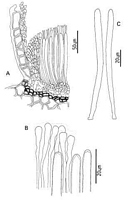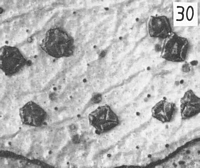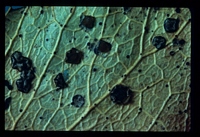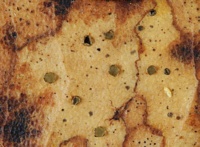|
 Coccomyces radiatus Coccomyces radiatus
BiostatusPresent in region - Indigenous. Non endemic
Images (click to enlarge)
Caption: Fig. 16 Coccomyces radiatus: A, ascocarp margin in cross-section. B, apices of asci and
paraphyses. C, asci. | 
Caption: Fig. 30 Macroscopic appearance of ascocarp (x 12).
C radiatus | 
Owner: Herb. PDD | 
Caption: Collected Waitakere Ranges, June 2008, on fallen Knightia excelsa leaves.
Owner: Herb PDD | |
Article: Johnston, P.R. (1986). Rhytismataceae in New Zealand. 1. Some foliicolous species of Coccomyces de Notaris and Propolis (Fries) Corda. New Zealand Journal of Botany 24(1): 89-124 (http://www.rsnz.org/publish/abstracts.php).
Description: Ascocarps found on fallen leaves, more commonly on lower surface, in pale brown to yellow
lesions. Lesions not associated with zone lines. Ascocarps 5-6 sided, more or less round in
outline, 0.5-1 mm diam. Upper wall black to dark grey with broad, pale zones along future
lines of opening, or more or less concolorous with surrounding host tissue, apart from narrow,
black line marking edge of ascocarp. Opening by 4-6 splits in the covering layer, with the
folded-back flaps of tissue often eroding to widely expose the yellow hymenium. No lip cells.
Pycnidia absent.
Ascocarps subepidermal. In vertical section upper stromatal layer 10-12 µm wide, of three
to four layers of pale brown to hyaline cells, thin walled. rounded, 2.5-5 µm diam. Lower
stromatal layer 20-30 µm wide, of three to four layers dark brown, more or less globose
cells, thick walled, up to 8 µm diam. Subhymenium 20-30 µm wide, of hyaline, thin
walled cells. Excipulum developing from the marginal paraphyses. Excipular elements
becoming swollen, 4-5 µm diam., and closely septate near apices, septa 4-10 µm apart.
Paraphyses 2 µm diam., swollen to 4-6 µm diam. at the clavate apices, embedded in
yellow gel, extending 15-20 µm beyond asci. Asci cylindric. 102-156 x 4.5-6.5(-7) µm,
apex rounded wall thickened to 1.5-2.5 µm at apex with a small central pore, non-amyloid,
8-spored. Ascospores filiform, (77-)88-108 x 1-1.8 µm, tapering to one end, 0-1 septate,
more or less straight when released, distinct gelatinous sheath.
CHARACTERISTICS IN CULTURE: A low percentage of the ascospores of PDD 43961
and PDD 44685 germinated on agar plates. Colonies on oatmeal agar 5-8 cm diam. after 10
weeks; aerial mycelium dense, erect, cottony, white, with small, scattered patches of black,
stringy hyphae; agar not discoloured. Remaining sterile.
Habitat: Found in New Zealand on fallen leaves of a wide range of host plants, including
Knightia excelsa, Dracophyllum species, Weinmannia racemosa, Leptospermum scoparium J.
R. et G. Forst., Dicksonia squarrosa, Metrosideros fulgens, and Nothofagus menziesii.
Previously known from North and South America on Rhododendron species and other,
unidentified hosts (Sherwood 1980).
Notes: The collections of this species from New Zealand were indistinguishable from the
type specimen of C. radiatus in both macroscopic and microscopic appearance. Sherwood
(1980) described the ascospore length as 60-75 µm. In my study of the type specimen
ascospores of up to 98 µm long were seen. This matched spore lengths from the New
Zealand collections. C radiatus is often found mixed on the same leaf with other
Rhytismataceous taxa, and various species belonging to Lophodermium and Hypoderma.
|